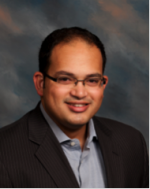From Neuroscience to Strategic Consultant
This article was originally published in Results & Discussion, Issue 2, Fall 2015.
From Neuroscience to Strategic Consultant
By Courtney Anthony-Bricker, graduate student

Anuraag Sarangi is the quintessential alumni success story. After Dr. Sarangi earned his Ph.D. in neuroscience from Vanderbilt University in 2009, he completed a brief stint as a postdoc at the University of North Carolina at Chapel Hill. From there, he transitioned into his current role of strategic consultant for ETHOS Health Communications. Dr. Sarangi recently returned to Vanderbilt as an invited speaker for the 2015 BRET career symposium. Prior to the symposium, Dr. Sarangi sat down with me to discuss his journey from academia to industry, his work at ETHOS, and advice on how to flourish in your post-graduate career.
Before Dr. Sarangi joined the Neuroscience Graduate Program at Vanderbilt, he acquired two degrees in computer science. During that time, he enjoyed building and creating tools for scientists and researchers, but found something lacking. “I noticed that I was getting a superficial understanding of the science involved because I was really concentrating more on the tools,” he said. “I really wanted to get a deeper understanding of the science. So, that prompted me to look at opportunities after my bachelor’s and master’s.”
Dr. Sarangi spoke with professors at Indiana University and took several courses in neuroscience, including cognitive neuroscience. “I really developed a fascination with neuroscience. Vanderbilt has an awesome Neuroscience Graduate Program. I joined the lab of Michael Cooper, M.D. in the Department of Neurology. I was bridging translational science and preclinical science and it was really exciting work. I got hooked on it and pursued my Ph.D. in neuroscience. Now, I feel like I have a greater understanding of the science and I also appreciate how the tools I was developing in computer science were helping scientists do their research.”
During his time in graduate school, Dr. Sarangi co-founded and served as co-director of the academic chapter of the Tennessee Biotechnology Association (TBA) (now Life Science Tennessee). His involvement with the TBA and other professional organizations during his training fostered the development of his networking and leadership skills. His interactions with these organizations also eventually informed his transition from academia to industry. “Developing relationships through the networking opportunities provided by these professional organizations was invaluable.”
Throughout our chat, Dr. Sarangi frequently stressed the importance of networking. “Networking is essential. It’s an important skill that one needs to continue to develop, even after you’ve chosen a particular career path. In my case, networking was essential in opening up not just industry contacts, but also the job opportunities I eventually secured. My current position was actually acquired through networking at a career symposium at University of North Carolina at Chapel Hill. My current manager was giving a talk at the career symposium. I approached her after the talk because I was very interested in what she was doing. She liked my resume, so she forwarded it to HR and I got a call for an interview. Several rounds later, I got the job.”
As a strategic consultant for ETHOS, Dr. Sarangi’s job consists of two primary roles: strategic advisor to pharmaceutical clients and team-lead within ETHOS. His dual role within the company provides him with numerous responsibilities and requires constant communication with clients and members of his team. “The bulk of my work at ETHOS stems from interfacing with pharmaceutical marketing clients. I continue to explore and talk to them about strategies that are relevant to their product or brand within the market place and how to expand and grow that particular product or brand. I explore different ways of communicating the medical science behind the product to the different stakeholders involved. The other role that I have is to lead my internal team at ETHOS. We have different teams at ETHOS that focus on one or a few specific clients. My team is a relatively large cross-functional team consisting of about 15 people. Together, we deliver on important client projects, whether they’re strategic projects to gain insights from the marketplace or education and communication projects to compliantly provide information to the medical community about a product. As the team leader, I am providing oversight across different groups within my team. I’m also involved in managing resources within the company and securing new business opportunities for ETHOS.”
As we wrapped up our conversation, Dr. Sarangi offered some valuable insights on the challenges involved in establishing work-life balance in industry, which is a constant struggle both in industry and in bench science. “At a basic level, my weekdays tend to be worse now, but my weekends tend to be better. During my weekdays, I am constantly in communication-mode with clients and my team, and there are instances where things can be somewhat unpredictable. However, most weekends tend to be free, where you really disconnect and recharge yourself. The key is flexibility and a supportive professional and personal environment. ”
